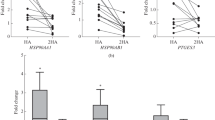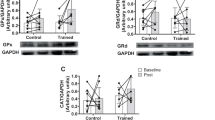Extracellular concentration of heat shock protein (Hsp) with a molecular weight of 70 kDa (Hsp70) rapidly increases in the serum in response to stress and returns to the basal level during recovery. Further regulation of its blood concentration is unclear. A possible regulator is HspBP1, a protein binding Hsp70. Binding to ATPase domain of Hsp70, HspBP1 inactivates it, thus acting as a factor of nucleotide exchange. Blood sera from athletes were examined at the beginning and end of the last mesocycle of the training period by two-staged immunoaffinity test system. The concentration of HspBP1 increased with decreasing Hsp70 concentration under conditions of long-term training. Presumably, the dynamics of Hsp70 and HspBP1 concentrations can serve as the test for evaluating the adaptation potential.
Similar content being viewed by others
References
D. A. Sakharov, A. V. Stepanov, M. U. Shkurnikov, and A. G. Tonevitsky, Byull. Eksp. Biol. Med., 147, No. 3, 335–340 (2009).
P. Bork, C. Sander, and A. Valencia, Proc. Natl. Acad. Sci. USA, 89, No. 16, 7290–7294 (1992).
E. Fehrenbach, A. M. Niess, E. Scholtz, et al., J. Appl. Physiol., 89, No. 2, 704–710 (2000).
K. M. Flaherty, C. DeLuca-Flaherty, and D. B. McKay, Nature, 346, 623–628 (1990).
M. Khassaf, R. B. Child, A. McArdle, et al., J. Appl. Physiol., 90, No. 3, 1031–1035 (2001).
Y. Liu, S. Mayr, A. Opitz-Gress, et al., Ibid., 86, No. 1, 101–104 (1999).
C. A. McLellan, D. A. Raynes, and V. Guerriero, J. Biol. Chem., 278, No. 21, 19,017–19,022 (2003).
J. P. Morton, A. C. Kayani, A. McArdle, and B. Drust, Sports Med., 39, No. 8, 643–662 (2009).
P. Narasimhan, R. A. Swanson, S. M. Sagar, and F. R. Sharp, Glia, 17, No. 2, 147–159 (1996).
D. A. Raynes and V. Guerriero Jr., J. Biol. Chem., 273, No. 49, 32,883–32,888 (1998).
H. Wegele, L. Muller, and J. Buchner, Rev. Physiol. Biochem. Pharmacol., 151, 1–44 (2004).
C. N. White, L. E. Hightower, and R. J. Schultze, Mol. Biol. Evol., 11, No. 1, 106–119 (1994).
P. Yamada, F. Amorim, P. Moseley, and S. Schneider, Sports Med., 38, No. 9, 715–733 (2008).
Author information
Authors and Affiliations
Corresponding author
Additional information
Translated from Byulleten’ Eksperimental’noi Biologii i Meditsiny, Vol. 149, No. 5, pp. 574–578, May, 2010
Rights and permissions
About this article
Cite this article
Grebenyuk, E.S., Stupnikova, T.V., Sakharov, D.A. et al. Long-Term Exercises Increase the Concentration of HspBP1, a Co-Chaperone of 70-KDa Heat Shock Protein. Bull Exp Biol Med 149, 640–644 (2010). https://doi.org/10.1007/s10517-010-1013-1
Received:
Published:
Issue Date:
DOI: https://doi.org/10.1007/s10517-010-1013-1




